A century from now when historians look back at how we coped with the 2020 pandemic, two things will stand out: toilet paper and home cooking.
During the past several months, many of us have sheltered in place at home, willingly or not. Early into the lockdown, bloggers began posting stories about how they planned to spend their newfound leisure time learning to speak Mandarin or reading all the unread books on their shelves, starting with War and Peace. Others vowed to run five miles a day, perfect their putt in the backyard, clean out closets, lose 30 pounds. Most of those manifestos lasted as long as New Year's resolutions do. The only "pandemic promise" everyone seemed to share was a desire to expand their culinary horizons—at home.
Sure, you could order takeout barbecue for curbside pick up, or call for a pizza delivered to your door. But even those options soon lost their luster. How much cholesterol can you absorb before clogged arteries keep you from lifting the phone?
It was enough to kill anyone's appetite.
My husband and I counted ourselves among the fortunate: We already knew how to cook, and we enjoy working together in the kitchen. Since mid-March, we've been trying out new recipes from cookbooks that we didn't have time to read before. We've swapped recipes with friends and found new culinary ideas online. And we've been making our own favorite dishes from my latest cookbook, T-Bone Whacks and Caviar Snacks: Cooking with Two Texans in Siberia and the Russian Far East.

When we lived in Siberia in the mid-1990s, there were no modern supermarkets and very few places to eat out. No phone, no TV, and no car for going grocery shopping. Our apartments were tiny. Public utilities (water, electricity, heating) were iffy. And our three-burner kitchen stove was so erratic that we called it "the stove from hell."
Shopping for food was a daily chore after work and on weekends, as we scoured the sparsely stocked stores and better-supplied farmers' markets for whatever products might be available that day, even that hour. Eggs disappeared from the shelves for a couple of weeks at a time. Sugar couldn't be found anywhere for two months. Flour—scooped out of wooden barrels and weighed on an old-fashioned scale—was often so adulterated with impurities that we had to sift them out before using it.
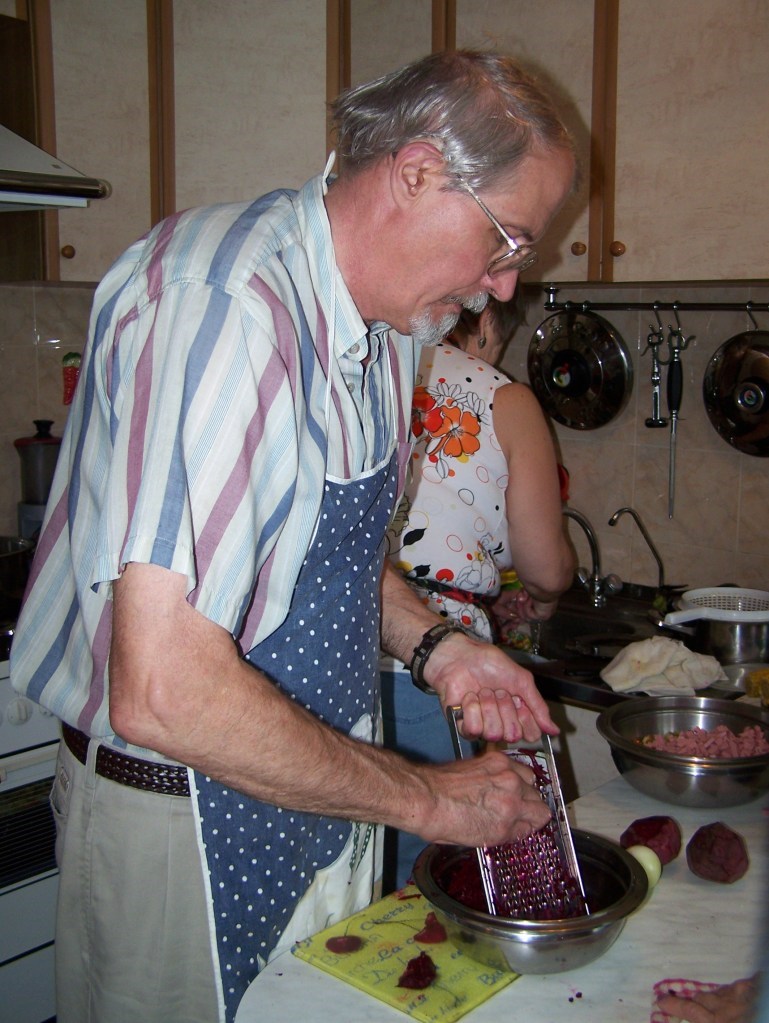
Despite those difficulties, we ate very well in Siberia. Cooking at home every day was not only necessary, but also a way to brighten up the dark Siberian winters, especially when we were cooped up in our apartments for days at a time. We enjoyed making meals from whatever ingredients happened to be available. We experimented with new recipes from friends and cookbooks. We made tried-and-true dishes from recipes we'd brought with us from home. And we gave informal dinner parties with friends and colleagues to celebrate holidays, weddings, birthdays, or just the serendipity of finding fresh greens at the market that day.
Comfort foods sustained us through those challenging times in Russia. So they're perfect for helping us cope with the current crisis, too. Even when faced with outside forces beyond our control, we can be in control in our kitchens. The following recipes are for some of my favorite comfort foods, easy-to-make desserts guaranteed to lower the anxiety level in your kitchen. You probably have most of the ingredients in your pantry and fridge already.
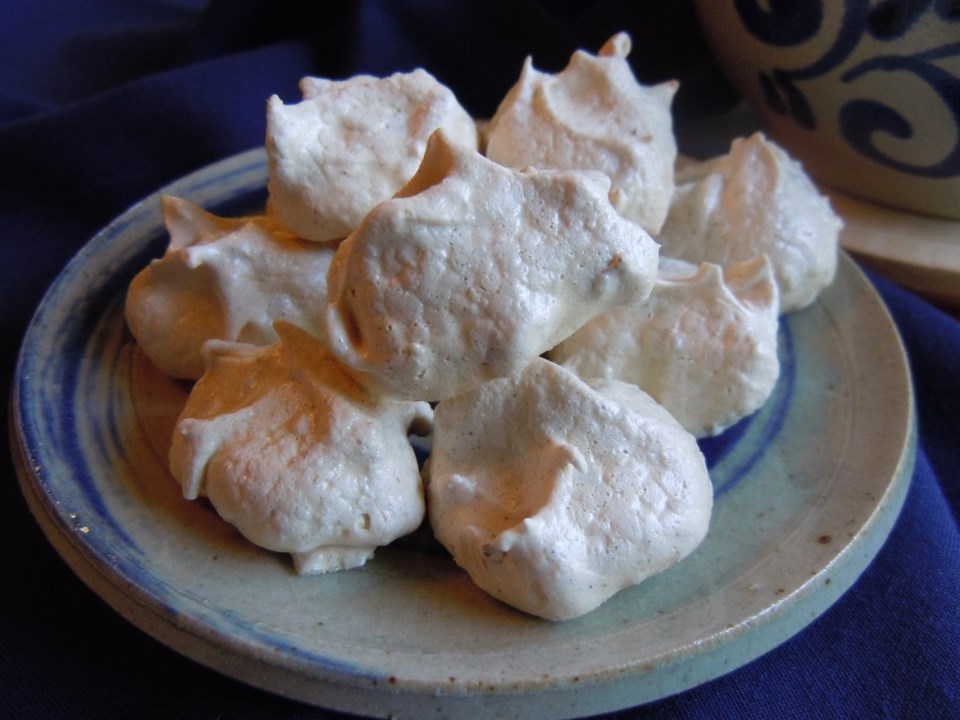
Pine Nut Meringues
In Russia, meringue cookies are often baked at Easter, to use up the egg whites left over from making traditional Russian Easter desserts that are rich in egg yolks. Toasted pine nuts give a distinctive Siberian flavor to these seductive cookies, which won a prize in the Dallas Morning News 2017 Holiday Baking Contest.
Note: It's best to make these on a dry (not humid) day.
- 1/2 cup toasted pine nuts, coarsely chopped*
- 1 cup sugar
- 2 teaspoons cornstarch
- 4 large egg whites, at room temperature
- 1 teaspoon vanilla extract
- 1/8 teaspoon salt
*Toast the pine nuts in advance for about 8 minutes in a preheated 325°F. oven. Cool before chopping.
- Preheat the oven to 225°F. Line 2 baking sheets with parchment paper. (You'll need 2 baking sheets that can sit side-by-side on the middle rack of your oven.)
- Whisk the sugar and cornstarch together in a small bowl.
- With an electric mixer on high speed, beat the egg whites, vanilla, and salt together in a large bowl until soft peaks form. Decrease the mixer speed to medium, and very slowly add the sugar, beating constantly. Scrape down the sides occasionally with a rubber spatula. Then increase the mixer speed to high and beat until the egg whites are glossy and stiff peaks form. Fold in the chopped pine nuts.
- Drop the mixture by well-rounded teaspoonfuls onto the baking sheets, placing the meringues about 1/2-inch apart.
- Bake at preheated 225°F. for 1 hour, then turn off the oven and leave the meringues inside for 2 more hours. Be patient: Do not open the oven door! Store the meringues in a tightly covered container.
Makes 48 irresistible, crunchy meringue cookies.
From T-Bone Whacks and Caviar Snacks: Cooking with Two Texans in Siberia and the Russian Far East, by Sharon Hudgins (University of North Texas Press, 2018)
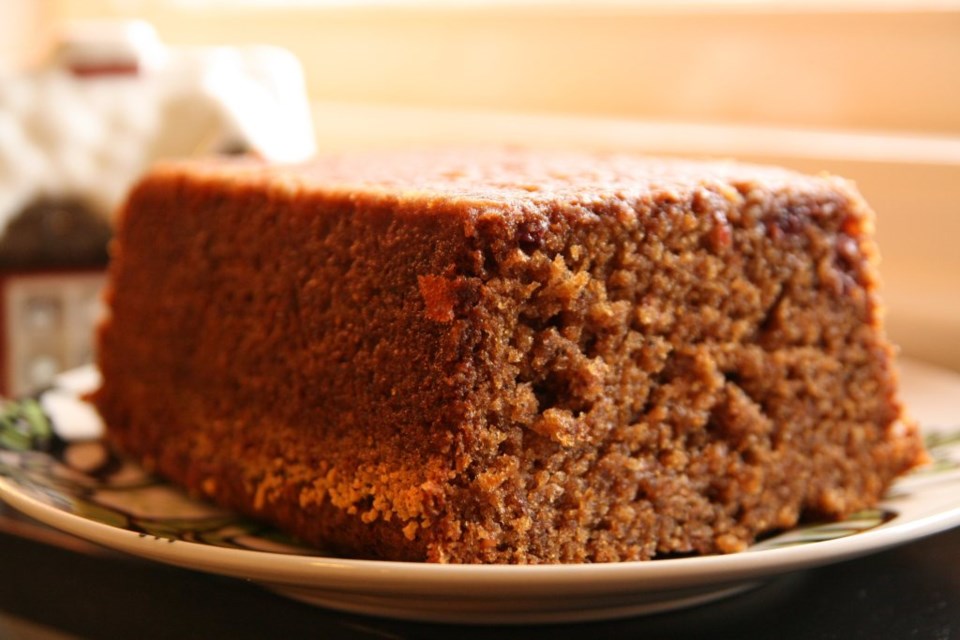
Scottish Gingerbread Squares
We first made this spicy gingerbread when we lived in a cottage in the Scottish Highlands—and liked it so much that we carried the recipe with us to Siberia, too. This recipe is perfect for places where ingredients are scarce, because it requires no butter, milk, or eggs.
Note: It is important to use an 8-inch square baking pan for this recipe.
- 2 cups all-purpose flour
- 3/4 cup dark brown sugar, firmly packed
- 2 teaspoons baking powder
- 1-1/2 teaspoons ground ginger
- 1 teaspoon ground cinnamon
- 1/2 teaspoon ground cloves
- 1/2 teaspoon ground nutmeg
- 1/4 teaspoon salt
- 3/4 cup very hot tap water
- 1/2 cup treacle (or unsulfured dark molasses)
- 1/4 cup vegetable oil
- Preheat the oven to 350° F. Butter or oil an 8-inch square baking pan.
- Whisk the flour, sugar, baking powder, ginger, cinnamon, cloves, nutmeg, and salt together in a medium bowl, until well combined. Mix the hot water, treacle (or molasses), and oil in a separate bowl, stirring well to combine.
- Make a well in the center of the dry ingredients, pour in the liquid mixture, and stir gently, just until the ingredients are blended and no large lumps remain. Do not overbeat or the gingerbread will be tough.
- Spread the batter evenly in the baking pan. Bake at 350° F. for 25 to 30 minutes, or until a skewer inserted in the center comes out clean. Let the gingerbread cool in the pan, set on a wire rack, then cut into 2-inch squares. Wrap leftovers tightly in foil or plastic wrap for storage.
Makes: 16 squares.
This dark-colored, densely textured gingerbread tastes even better the day after baking, when the flavors have had time to develop. For a lighter-colored, more delicate tasting version, substitute white sugar and honey for the brown sugar and treacle/molasses.
From T-Bone Whacks and Caviar Snacks: Cooking with Two Texans in Siberia and the Russian Far East, by Sharon Hudgins (University of North Texas Press, 2018)
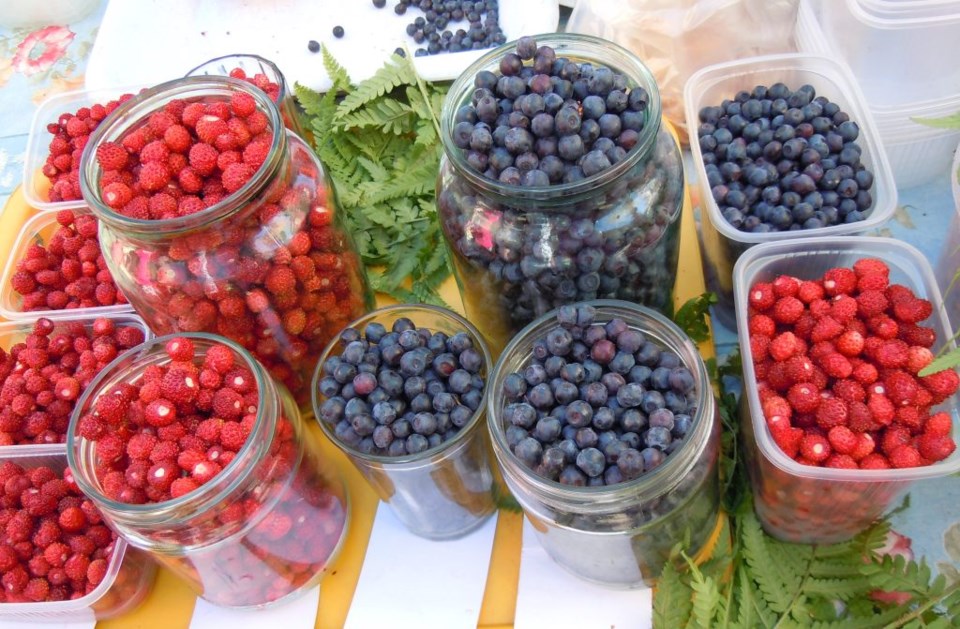
Siberian Frozen Berry Cream
This recipe was given to me by a Siberian friend who makes it with fresh white cheese and whatever wild berries are available (cranberries, blueberries, raspberries, wild strawberries). I like to serve this pretty dessert in stemmed parfait glasses, but the mixture can also be dolloped onto a baking sheet to make "frozen cookies."
- 2 cups fresh or frozen unsweetened berries
- 1 pound (16 ounces) whole milk ricotta cheese
- 3 cups confectioners' sugar
- 1 tablespoon fresh lemon juice
- 1 teaspoon vanilla extract
- 2 cups heavy whipping cream, well chilled
- Garnish: 1 cup toasted pine nuts, coarsely chopped
- Stem and wash the berries, letting them drain well in a colander. Coarsely chop the berries in a food processor, but don't turn them to mush.
- Press the ricotta cheese through a fine sieve into a large bowl. Stir in the confectioners' sugar, then beat the mixture by hand with a wooden spoon until no lumps remain. Stir in the berries (with their juice), lemon juice, and vanilla extract. Mix well. Cover the bowl and refrigerate for 30 minutes.
- Beat the whipping cream in a separate large bowl until very stiff. Fold the whipped cream into the berry mixture.
- Spoon the berry cream into individual dessert bowls or stemmed parfait glasses. Cover with plastic wrap and freeze until needed.
- Toast the pine nuts in a single layer on a baking sheet in a preheated 325° F. oven for 8 to 10 minutes. Watch carefully so they don't burn! Cool completely before chopping.
- To serve, let the frozen berry cream sit, uncovered, at room temperature for about 10 minutes, then garnish with toasted pine nuts sprinkled over the top. Serve immediately.
Makes 8 servings (approximately 1 cup each).
Note: You can also make "frozen cookies" by dropping heaping tablespoonfuls of the berry cream mixture onto 2 large baking sheets lined with wax paper, spacing the dollops about 1 inch apart. Freeze until very firm. (Omit the pine nut garnish.)
From T-Bone Whacks and Caviar Snacks: Cooking with Two Texans in Siberia and the Russian Far East, by Sharon Hudgins (University of North Texas Press, 2018)
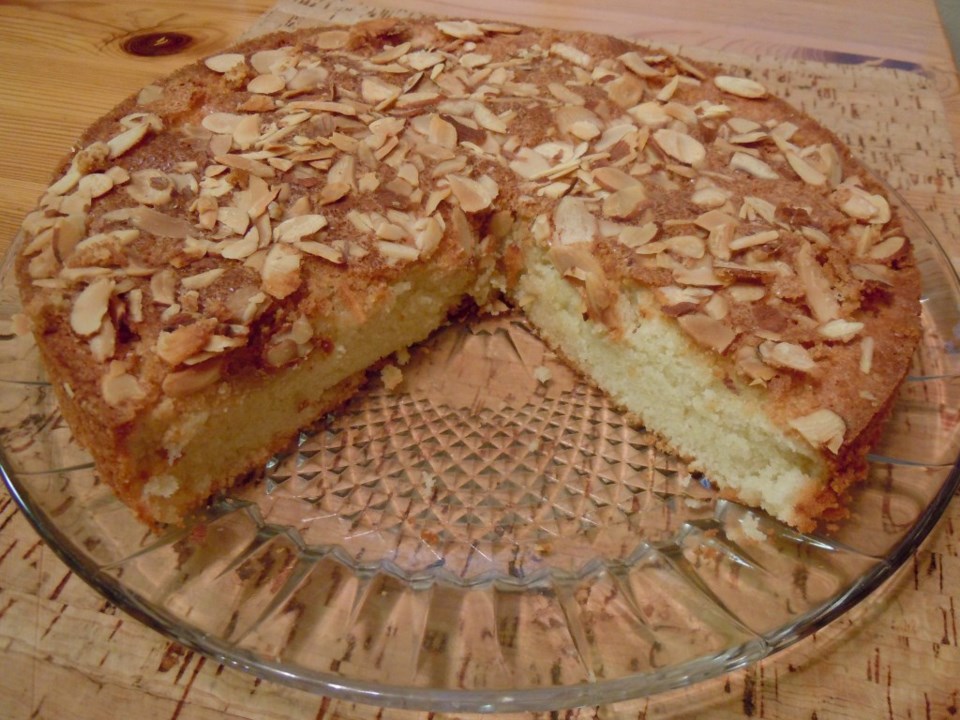
Spanish Almond Torte
This delicious, easy-to-make one-layer cake comes from the Galician capital of Santiago de Compostela in northwest Spain. It honors Saint James (Santiago), one of the Twelve Apostles and the patron saint of Spain, whose remains are supposedly buried in the city's great cathedral. The classic version of this torte is covered with a heavy layer of confectioners' sugar, with the Cross of Saint James stenciled on it. But this variation uses crunchy turbinado sugar and flaked almonds on top.
Note: It's important to use a 9-inch round cake pan.
- 1 cup plus 2 tablespoons white sugar
- 3 large whole eggs
- 3 large egg whites
- 1/2 teaspoon salt
- 1/2 teaspoon almond extract
- 1/2 teaspoon vanilla extract
- 1 teaspoon edible orange blossom water (optional)*
- 2-1/2 cups blanched-almond flour
- 3 tablespoons turbinado or demerara sugar
- 1/3 cup sliced almonds (almond flakes), coarsely chopped
*Available at specialty food stores. Or substitute the finely grated peel of 1/2 orange or 1 whole lemon.
- Heat the oven to 350°F. Butter the bottom of a 9-inch round cake pan and line the bottom with baking parchment, then butter the parchment (but not the sides of the pan).
- Combine the white sugar, whole eggs, egg whites, and salt in a large bowl. Whisk vigorously until well combined (about 1 minute). The mixture should be slightly frothy, but the sugar won't be completely dissolved. Whisk in the (optional) orange blossom water, or the grated orange or lemon peel. Then whisk in the almond flour, 1/2 cup at a time, until well incorporated
- Pour the batter into the prepared baking pan. Sprinkle the turbinado sugar evenly over the top, then sprinkle the chopped almond flakes to cover the top of the torte.
- Bake for 45 to 50 minutes, until the top is nicely browned, the cake just begins to pull away from the sides of the pan, and the crust feels firm when you gently press it with your finger.
- Let the cake cool in the pan on a wire rack for 10 minutes. Run a knife around the edge of the cake, then invert the cake onto a plate. Remove the pan and parchment paper. Then re-invert the cake onto a nice serving plate. Let it cool completely before serving. Cut with a serrated knife to serve.
Makes 10 very rich slices.
Adapted from Christopher Kimball's Milk Street Recipes, 177milkstreet.com




